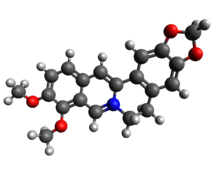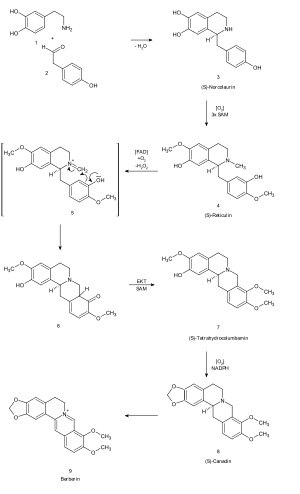Berberine

| |

| |
| Names | |
|---|---|
| IUPAC name
9,10-Dimethoxy-7,8,13,13a-tetradehydro-2′H-[1,3]dioxolo[4′,5′:2,3]berbin-7-ium
| |
| Systematic IUPAC name
9,10-Dimethoxy-5,6-dihydro-2H-7λ5-[1,3]dioxolo[4,5-g]isoquinolino[3,2-a]isoquinolin-7-ylium[2] | |
| Other names | |
| Identifiers | |
3D model (JSmol)
|
|
| 3570374 | |
| ChEBI | |
| ChEMBL | |
| ChemSpider | |
| DrugBank | |
| ECHA InfoCard | 100.016.572 |
| EC Number |
|
| KEGG | |
PubChem CID
|
|
| UNII | |
CompTox Dashboard (EPA)
|
|
| |
| |
| Properties | |
| C20H18NO4+ | |
| Molar mass | 336.366 g·mol−1 |
| Appearance | Yellow solid |
| Melting point | 145 °C (293 °F; 418 K)[3] |
| Slowly soluble[3] | |
Except where otherwise noted, data are given for materials in their standard state (at 25 °C [77 °F], 100 kPa).
| |
Berberine is a quaternary ammonium salt from the protoberberine group of benzylisoquinoline alkaloids, occurring naturally as a secondary metabolite in some plants including species of Berberis, from which its name is derived.
Due to their yellow pigmentation, raw Berberis materials were once commonly used to dye wool, leather, and wood.[4] Under ultraviolet light, berberine shows a strong yellow fluorescence,[5] making it useful in histology for staining heparin in mast cells.[6] As a natural dye, berberine has a color index of 75160.
Research
[edit]Studies on the pharmacological effects of berberine, including its potential use as a medicine, are preliminary basic research: some studies are conducted on cell cultures or animal models, whereas clinical trials investigating the use of berberine in humans are limited.[7] A 2023 review study stated that berberine may improve lipid concentrations.[8] High-quality, large clinical studies are needed to properly evaluate the effectiveness and safety of berberine in various health conditions, because existing studies are insufficient to draw reliable conclusions.[7]
Berberine supplements are widely available in the U.S. but have not been approved by the U.S. Food and Drug Administration (FDA) for any specific medical use. Researchers publicly warn that studies linking berberine to supposed health benefits are limited. Furthermore, the quality of berberine supplements can vary between different brands. A study conducted in 2017 found that out of 15 different products sold in the U.S., only six contained at least 90% of specified berberine amount.[9][10]
Biological sources
[edit]- Berberis vulgaris (barberry)
- Berberis aristata (tree turmeric)
- Berberis thunbergii
- Fibraurea tinctoria
- Mahonia aquifolium (Oregon grape)
- Hydrastis canadensis (goldenseal)
- Xanthorhiza simplicissima (yellowroot)
- Phellodendron amurense (Amur cork tree)[11]
- Coptis chinensis (Chinese goldthread)
- Tinospora cordifolia
- Argemone mexicana (prickly poppy)
- Eschscholzia californica (California poppy)
Berberine is usually found in the roots, rhizomes, stems, and bark.[12]
Biosynthesis
[edit]
The alkaloid berberine has a tetracyclic skeleton derived from a benzyltetrahydroisoquinoline system with the incorporation of an extra carbon atom as a bridge. Formation of the berberine bridge is rationalized as an oxidative process in which the N-methyl group, supplied by S-adenosyl methionine (SAM), is oxidized to an iminium ion, and a cyclization to the aromatic ring occurs by virtue of the phenolic group.[13]
Reticuline is the immediate precursor of protoberberine alkaloids in plants.[14] Berberine is an alkaloid derived from tyrosine. L-DOPA and 4-hydroxypyruvic acid both come from L-tyrosine. Although two tyrosine molecules are used in the biosynthetic pathway, only the phenethylamine fragment of the tetrahydroisoquinoline ring system is formed via DOPA; the remaining carbon atoms come from tyrosine via 4-hydroxyphenylacetaldehyde.[15]
References
[edit]- ^ a b c The Merck Index, 14th ed., 1154. Berberine
- ^ IUPAC Chemical Nomenclature and Structure Representation Division (2013). "P-73.3.1". In Favre HA, Powell WH (eds.). Nomenclature of Organic Chemistry: IUPAC Recommendations and Preferred Names 2013. IUPAC–RSC. ISBN 978-0-85404-182-4.
- ^ a b The Merck Index, 10th Ed. (1983), p.165, Rahway: Merck & Co.
- ^ Gulrajani ML (2001). "Present status of natural dyes". Indian Journal of Fibre & Textile Research. 26: 191–201. Archived from the original on 2021-11-20. Retrieved 2017-12-28 – via NISCAIR Online Periodicals Repository.
- ^ Weiß D (2008). "Fluoreszenzfarbstoffe in der Natur" (in German). Archived from the original on 9 March 2007. Retrieved 17 July 2009.
- ^ "B3251 Berberine chloride form". Sigma-Aldrich. 2013. Archived from the original on 7 September 2012. Retrieved 2 Aug 2013.
- ^ a b Song D, Hao J, Fan D (October 2020). "Biological properties and clinical applications of berberine". Front Med. 14 (5): 564–582. doi:10.1007/s11684-019-0724-6. PMID 32335802. S2CID 216111561.
- ^ Hernandez AV, Hwang J, Nasreen I, et al. (2023). "Impact of Berberine or Berberine Combination Products on Lipoprotein, Triglyceride and Biological Safety Marker Concentrations in Patients with Hyperlipidemia: A Systematic Review and Meta-Analysis". J Diet Suppl. 21 (2): 242–259. doi:10.1080/19390211.2023.2212762. PMID 37183391. S2CID 258687419. Archived from the original on 2023-06-01. Retrieved 2023-08-28.
- ^ Funk RS, Singh RK, Winefield RD, Kandel SE, Ruisinger JF, Moriarty PM, Backes JM (May 2018). "Variability in Potency Among Commercial Preparations of Berberine". J Diet Suppl. 15 (3): 343–351. doi:10.1080/19390211.2017.1347227. PMC 5807210. PMID 28792254.
- ^ Subbaraman N (14 June 2023). "The Cheaper Weight-Loss Alternative Riding the Ozempic Wave". Wall Street Journal. Archived from the original on 29 December 2023. Retrieved 29 December 2023.
- ^ Cicero AF, Baggioni A (2016). "Berberine and Its Role in Chronic Disease". Anti-inflammatory Nutraceuticals and Chronic Diseases. Advances in Experimental Medicine and Biology. Vol. 928. Cham: Springer International Publishing. pp. 27–45. doi:10.1007/978-3-319-41334-1_2. ISBN 978-3-319-41332-7. ISSN 0065-2598. PMID 27671811.
- ^ "Berberine". PubChem, National Library of Medicine, US National Institutes of Health. March 9, 2020. Archived from the original on March 5, 2016. Retrieved March 10, 2020.
- ^ Dewick P (2009). Medicinal Natural Products: A Biosynthetic Approach (3rd ed.). West Sussex, England: Wiley. p. 357. ISBN 978-0-471-49641-0.
- ^ Park SU, Facchini PJ (June 2000). "Agrobacterium rhizogenes-mediated transformation of opium poppy, Papaver somniferum l., and California poppy, Eschscholzia californica cham., root cultures". Journal of Experimental Botany. 51 (347): 1005–16. doi:10.1093/jexbot/51.347.1005. PMID 10948228.
- ^ Dewick P (2009). Medicinal Natural Products: A Biosynthetic Approach (3rd ed.). West Sussex, England: Wiley. p. 358. ISBN 978-0-471-49641-0.
